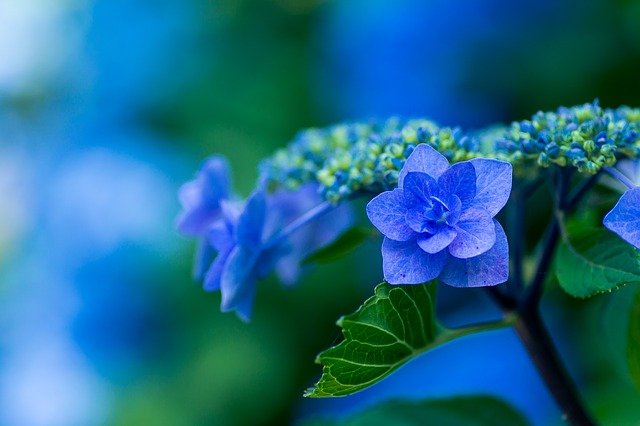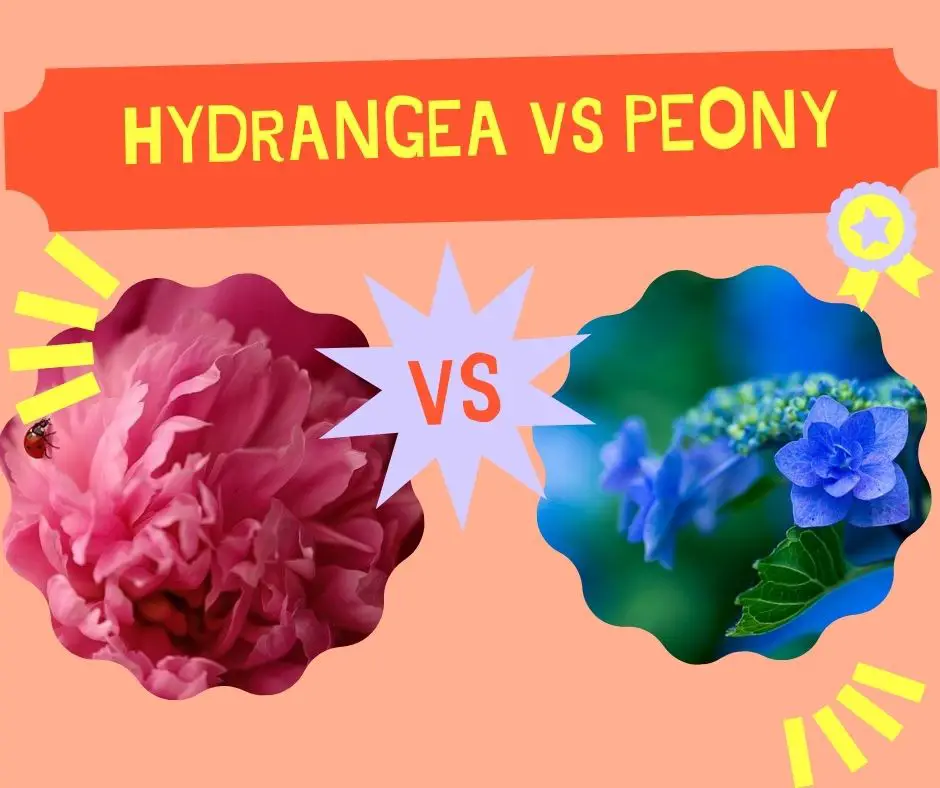Peonies and hydrangeas are plants that grow very beautiful flowers, so they are popular as some of the best flowering plants. So how do you choose when it comes to Hydrangea Vs Peony.
Appearance
Below are the ways you can check the difference visually between Peonies vs Hydrangeas.
Flowers
The main difference between hydrangeas and peonies is in the flowers. Peony flowers are much larger.
Peony flowers grow individually. They don’t grow in clusters. The size of the flowers is 2 to 6 inches, which is much larger than that of hydrangeas.
The size of the peonies, along with the large petals, looks beautiful. The number of flowers depends on the variety of the peony, but it is still considerable.
The center of the peony flowers is also a distinguishing feature of the plant. It consists of pistils and stamens that are comparatively large in size. With their bright yellow color, it creates a nice contrast with the petals.
The hydrangea flowers, on the other hand, are quite small in size. However, the flowers grow in large clusters, and the number of blooms is high.
Therefore, you can see a large number of inflorescences measuring 8 to 10 inches all over the hydrangea plant.
The number of flowers of the peony and the clusters of hydrangeas is similar, however, owing to the large size of clusters, hydrangea blooms look lusher.
Size
When it comes to size, peonies are generally smaller than hydrangeas.
Some peonies do reach 11 feet, but most of the ornamental varieties are smaller. The peony herbs are 2 to 3 feet in height and rarely reach 4 feet. The width is usually 3 feet.
The tree peonies are 4 to 6 feet high, sometimes going even higher than 7 feet. But tree peonies look more like a woody shrub than a typical tree.
Hydrangeas, on the other hand, are quite tall. They are also wider than peonies. Some hydrangea varieties can be 2 to 3 times larger than some varieties of peonies.
The oakleaf hydrangea is 5 feet in length and width, depending on the cultivar. Bigleaf hydrangea grows up to 6 to 7 feet in height, and 8 feet in width.
Hydrangea paniculate Grandiflora is one of the largest varieties of hydrangeas. It can exceed 20 feet in height and 15 feet in width.
The climbing hydrangea can climb up to 80 feet in length if there is a frame or tree of a suitable size.
Fragrance
When it comes to fragrance, hydrangeas have little to no fragrance. Some might find that oakleaf and paniculate hydrangeas do have a fragrance, but in general, hydrangeas do not emit any strong smell.
Peonies are very fragrant flowers. The fragrance of peonies can be smelled even from a distance, although it does not last for long.
The white varieties are the most fragrant peonies. Duchess de Nemours, a cultivar of white peonies has pure white petals and a very nice fragrance.
The pink double varieties also have an intense fragrance. With their number of rows of petals, the variety includes cultivars like Hermione and Cora Stubbs. The petals have a pretty shape and white parts.
Red peonies are not that fragrant, however, some cultivars like Henry Bockstoce have large blooms that are quite fragrant.
Blooming period – Hydrangea Vs Peony
Peonies

Peonies have a much shorter blooming period as compared to hydrangeas.
They bloom in late spring or early summer, somewhere between May and June. Depending on the variety of peonies, the flowers last from 7 to 10 days after which the petals start falling off.
While tree peonies have larger flowers, herb peonies bloom for a longer time. Some varieties, like Scarlet O’Hara, last longer than others.
A type of peonies, called Itoh, is a group of hybrid peonies created by crossing herb peonies and tree peonies for blooms that last longer. These blooms can last for up to 3 weeks and have large flowers that are 8 inches in size.
One disadvantage of peony flowers is that they cannot withstand heavy rain and wind. In this situation, all the petals will fall off. So, if the weather is not right, your peonies might not be in bloom for even one week.
A trick that gardeners use to prolong the blooming period is to plant varieties of peonies that have different flowering periods beside each other. That way, one can get a blooming garden for up to 2 months.
For your peonies to bloom for a longer time, you need to provide them with at least 4 to 6 hours of direct sunlight, and not more than 5 to 6 hours for tree peonies.
Prune the faded flowers so as to make way for new blooms. Use fungicides and pesticides to save the plants from getting infected by pests and diseases. Do not overfeed the plants to increase the number of blooms.
Hydrangeas

Hydrangeas start booming in late spring and continue until mid-summer. This means hydrangeas are in bloom for about 2 months.
Even after they fade, you can keep them on the plant and they will look good even faded and covered in frost. Some varieties bloom even longer, almost throughout the summer season.
This, however, depends on the variety of hydrangea and the climate and conditions.
Hydrangeas bloom on old wood or new wood, while some varieties grow on both old and new wood. This means that the plant flowers on the wood from last season in spring, which continue to bloom until mid-summer.
When the new wood forms during this season, the hydrangea blooms again from July to September.
Under optimal conditions and taking care of the plant properly by pruning the faded flowers, it can be possible for the plant to be continuously blooming throughout the season.
15 Best Blue Hydrangea Varieties and How to Choose between them?
Sunlight requirements
On average, hydrangeas need 6 hours of sunlight per day for blooming. The amount of sunlight also depends on the various varieties of hydrangeas.
In colder regions, hydrangeas can grow well even with longer exposure to the sun, around 8 hours, but they do need shade during afternoons. The diffused morning sunlight is the best for hydrangeas.
Too much sun can result in the hydrangea leaves withering and the flowers getting burned.
Peonies need at least 6 to 8 hours of direct sunlight. In open spaces, even 10 to 12 hours of sunlight can help them grow well.
The flowers will bloom and flourish. If the peonies do not get the required amount of sunlight, the plant may not flower properly.
However, in the hot regions, peonies will also benefit from some shade in the afternoon.
Winter Hardiness
Hydrangeas are woody plants, so they do not die back during winter. These plants can survive heavy frosts and some varieties can also grow in hardiness zone 3.
Peonies are herbaceous plants, which is why their foliage does not stay alive during winter. These plants die back in the fall and start to grow again in the next spring. However, tree peonies have woody stems like hydrangeas. This is why they can survive even in the winter.
If the plant does not lose its top part, it can spend its energy on forming larger flowers. This is what happens with hydrangeas and tree peonies, which is why they have large blooms.
Herbaceous peonies need to be pruned at the end of the season. Prune the plants to ground level and dispose of the plant remains so that they do not rot in the garden.
Can Hydrangeas Grow under Pine Trees? Tips that you can follow
Propagation methods
The methods of propagation for hydrangeas and peonies are different.
The rhizome needs to be divided for peonies to multiply. You need to separate the rhizome into two or more parts and plant them in a different place.
Further, you cannot propagate peonies with cuttings. You might not get any success by trying to root a branch of peony, except with tree peonies that can propagate through cuttings.
Hydrangeas, on the other hand, can be propagated by division, but it is not a recommended method. Instead, hydrangea can be best propagated through cuttings.
You can get up to 12 or more plants from one hydrangea shrub, while one peony will be able to give you only up to 5 new plants.
Additional support
Peonies often require external support.
Many times, once peonies reach a specific size, circumstances like heavy wind or rain can make the plants collapse and fall to the ground. The plant will not be the same as before if you don’t take any action.
You need to tie the branches of the peonies to support or make a frame around the plant in such a way that it can support its weight.
You can also tie the peonies with a rope. Also, you can poke a stick in the ground beside the plant and tie the stems to it. There are also external supports available in the market that you can use to hold up your peonies.
Hydrangeas are woody plants and are very strong. They do not require external support as they do not face this problem.
However, climbing hydrangea is a variety of hydrangea that grows by crawling upwards. This plant needs support to grow well.
Color-changing
A special feature of the hydrangea plant is that the blooms of hydrangea can change colors depending on the acidity of the soil.
In alkaline soil, the flowers are pink in color. You can add garden lime to achieve alkalinity in the soil. In acidic soil, the blooms are blue in color.
To make the soil acidic, you can add aluminum sulfate. A neutral soil will grow blooms in shades of purple. Peonies cannot change their colors of the flowers depending on other conditions.
Hope you now have the details required to choose between Hydrangea Vs Peony.


